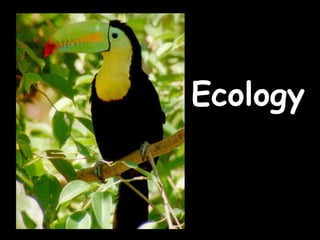
Ecology good
- 1. Ecology
- 8. Organism Population Community Biosphere Ecosystem
- 11. Community - several interacting populations that inhabit a common environment and are interdependent.
- 12. Ecosystem - populations in a community and the abiotic factors with which they interact (ex. marine, terrestrial)
- 33. = 1 species Type of relationship Species harmed Species benefits Species neutral Commensalism Parasitism Mutualism
- 36. Trophic Levels Producers- Autotrophs Primary consumers- Herbivores Secondary consumers-small carnivores Tertiary consumers- top carnivores E N E R G Y
- 49. Water cycle-
- 51. Carbon cycle-
- 52. Nitrogen cycle- Atmospheric nitrogen (N 2 ) makes up nearly 78%-80% of air. Organisms can not use it in that form. Lightning and bacteria convert nitrogen into usable forms.
- 53. Nitrogen cycle- Only in certain bacteria and industrial technologies can fix nitrogen. Nitrogen fixation -convert atmospheric nitrogen (N 2 ) into ammonium (NH 4 + ) which can be used to make organic compounds like amino acids. N 2 NH 4 +
- 54. Nitrogen cycle- Nitrogen-fixing bacteria: Some live in a symbiotic relationship with plants of the legume family (e.g., soybeans, clover, peanuts).
- 57. Atmospheric nitrogen Lightning Nitrogen fixing bacteria Ammonium Nitrification by bacteria Nitrites Nitrates Denitrification by bacteria Plants Animals Decomposers Nitrogen Cycle
Notas del editor
- What do you think about when I say ecology? Recycling? Acid rain?
- When I say environment you think what—weather. Well Ok but it it much more than that
- Just like with classification, ecology is hierarchal. Each level builds on itself and they fit together like nesting boxes.
- The lowest level is the individual. The organism. Here we see a salmon and a bear as examples of organisms. REMINDER: organisms die, species go extinct
- The next level is a population. A population consists of a single species living together and breeding. Give me an example of a population. Ex. large mouth bass living in Lake Meade. Beetles living under the same log. Here we have salmon spwning and two bears fishing.
- Next level is a community which is several populations living together and depending on each other. What does interdependent mean? An example of a community is shown here with the bear and the salmon. They both live in a common environment and the bear needs the fish for food? How does the salmon need the bear?
- Lets review. Organisms make up populations, populations make up communities, communities and abiotic factors make up ecosystems, and all of the ecosystems make up the biosphere. From one to many and each depending on the other.
- Although several species may share a habitat they each have their own niche. A niche is a very narrow range where a species fits within a habitat.
- Although several species may share a habitat they each have their own niche. A niche is a very narrow range where a species fits within a habitat.
- Although several species may share a habitat they each have their own niche. A niche is a very narrow range where a species fits within a habitat.
- How do they trap the sun’s energy? Through what process? What is that process similar to in animal cells?
- How do they trap the sun’s energy? Through what process? What is that process similar to in animal cells?
- Energy moves up the food chain through the producer/consumer relationship.
- Herbivores are the 1 st step up the food chain, they eat the producers
- Scavengers are a type of carnivore that eat dead animals, or carrion. Vultures, hyenas, crabs, deep sea fish-talk about distance from the sun and must eat the dead things that sink to the bottom, bottom feeders
- Scavengers are a type of carnivore that eat dead animals, or carrion. Vultures, hyenas, crabs, deep sea fish-talk about distance from the sun and must eat the dead things that sink to the bottom, bottom feeders
- Humans and bears are omnivores but a large and important subset of omnivores are the decomposers. They breakdown dead producers and release the energy back into circulation.
- Humans and bears are omnivores but a large and important subset of omnivores are the decomposers. They breakdown dead producers and release the energy back into circulation.
- Cleaning shrimp
- You can see here that this polar bear is no longer white.
- The Egyptian plover takes insects from the backs of buffaloes, giraffes and rhinos. The plover has also been observed taking leeches from the open mouths of crocodiles! In this association the plover receives a supply of food and the other animal rids itself of unwelcome pests
- The Egyptian plover takes insects from the backs of buffaloes, giraffes and rhinos. The plover has also been observed taking leeches from the open mouths of crocodiles! In this association the plover receives a supply of food and the other animal rids itself of unwelcome pests